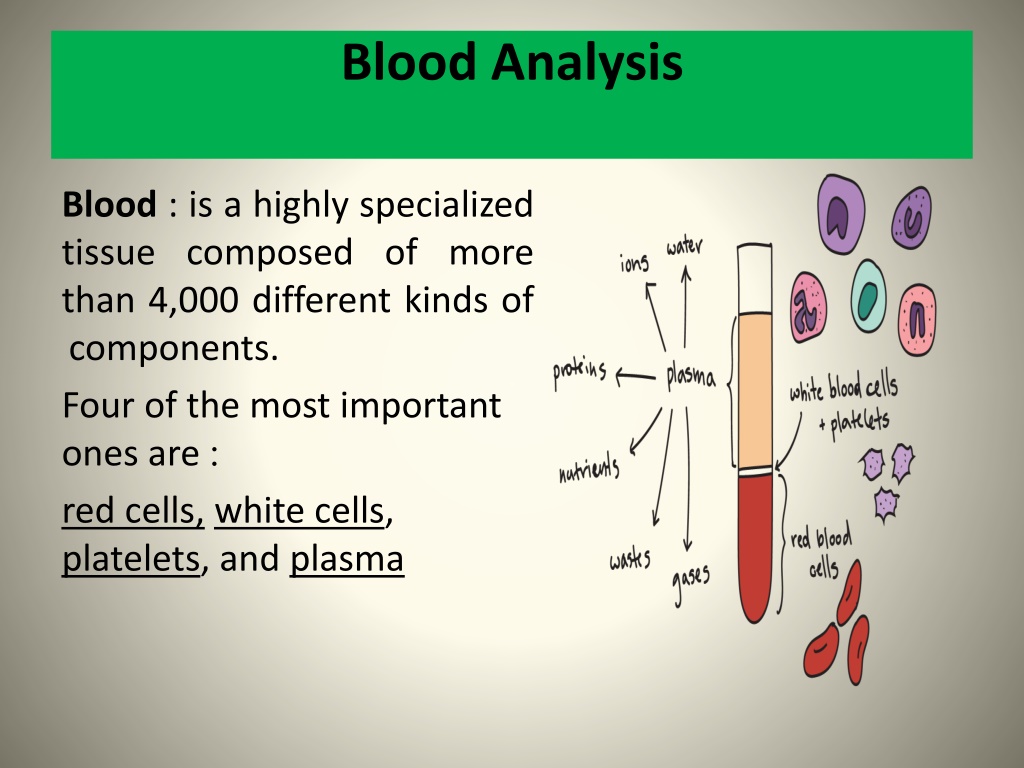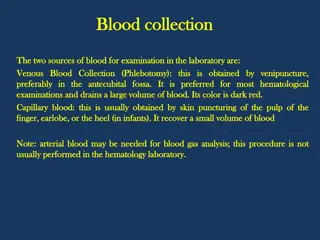Understanding the Importance of Blood Composition and Functions
Blood is a complex tissue composed of red cells, white cells, platelets, and plasma, each serving crucial functions such as oxygen transport, waste removal, and immune system support. Red cells contain hemoglobin for oxygen transport, while white cells play a key role in defending the body against infections. Granulocytes are a subset of white cells with distinct functions. By understanding the components and functions of blood, we gain insight into its vital role in maintaining overall health.
Uploaded on Oct 11, 2024 | 0 Views
Download Presentation

Please find below an Image/Link to download the presentation.
The content on the website is provided AS IS for your information and personal use only. It may not be sold, licensed, or shared on other websites without obtaining consent from the author. Download presentation by click this link. If you encounter any issues during the download, it is possible that the publisher has removed the file from their server.
E N D
Presentation Transcript
Blood Analysis Blood : is a highly specialized tissue composed of more than 4,000 different kinds of components. Four of the most important : ones are red cells, white cells, platelets, and plasma
BLOOD FUNCTIONS Blood responsible of : -transporting oxygen and nutrients to cells and getting rid of carbon dioxide, ammonia, and other waste products. -In addition, it plays a vital role in immune system and in maintaining a relatively constant body temperature
1-Red Cells erythrocytes, are relatively large microscopic cells nuclei. Red cells normally make up 40-50% of the total blood volume. They transport oxygen from the lungs to all of the living tissues of the body and carry away carbon dioxide. cells are produced continuously in bone marrow from stem cells at a rate of about 2-3 million cells per second. without The red
Hemoglobin is the gas transporting protein molecule that makes up 95% of a red cell. Each red cell has about 270,000,000 iron-rich hemoglobin molecules. People who are anemic generally have a deficiency in red cells, and subsequently feel fatigued due to a shortage of oxygen. The red color of blood is primarily due to oxygenated red cells. Human fetal hemoglobin molecules differ from those produced by adults in the number of amino acid chains
2-White Cells leukocytes, exist in variable numbers and types but make up a very small part of blood's volume--normally only about 1% in healthy people. Leukocytes are not limited to blood. They most notably in the spleen, liver, and lymph glands. Most are produced in bone marrow from the same kind of stem cells that produce red blood cells. Others are produced in the thymus gland, which is at the base of the neck. Some white cells are involved in defending the body against both infectious disease and foreign materials. There are several different types of white blood cells. They all have many things in common but are all distinct in form and function. A major distinguishing feature is the presence of granules; white blood cells are often characterized as granulocytes or a granulocytes
A-Granulocytes Granulocytes, also known as polymorph nuclear leukocytes are characterized by differently stained granules as viewed in their cytoplasm under light microscopy. These granules are membrane-bound enzymes that act primarily in the digestion of endocytic particles. There are three types of granulocytes : - Neutrophils defend against bacterial or fungal infection and other very small inflammatory processes. They are usually the first responders to microbial infection; their activity and death in large numbers forms pus. -Eosinophils primarily deal with parasitic infections. They are also the predominant inflammatory cells in allergic reactions. -Basophils are chiefly responsible for allergic and antigen response by releasing the chemical histamine, which causes dilation of the blood vessels.
A-Granulocytes https://figures.boundless.com/16276/large/granulocytes.png
B-Agranulocytes Agranulocytes, or mononuclear leukocytes, are leukocytes characterized by absence of granules in their cytoplasm. Agranulocytes contain lysosomes which are small vesicles containing digestive enzymes that break down any foreign matter that are endocytic by the cell. A granulocytes cells include: 1-Lymphocytes: they are three types : B-lymphocytes, which produce humoral immune response. T-lymphocytes which participate in the cell-mediated immune response. The null group which contains natural killer cells; cytotoxic cells that participate in the innate immune response. antibodies in the
B-Agranulocytes 2-Monocytes present pieces of pathogens to T cells so that the pathogens may be recognized again and killed, or so that an antibody response may be mounted 3- Macrophages are monocytes that have migrated out of the blood stream into the body tissues. They take up and destroy necrotic cell debris and foreign material including viruses, bacteria, and tattoo ink.
3-Platelets Platelets , or thrombocytes , are nuclei that work with blood clotting chemicals at the site of wounds ,by adhering to the walls of blood vessels, and plugging the rupture in the vascular wall. They also can release coagulating chemicals which cause clots to form in the blood that can plug up narrowed blood vessels. Thirteen different blood clotting factors, in addition to platelets, need to interact for clotting to occur. They do so in a cascading manner, another. Hemophiliacs lack the ability to produce blood factor 8 or 9. cell fragments without one factor triggering
3-Platelets Platelets are not equally effective in clotting blood throughout the entire day. The body's circadian rhythm system (its internal biological clock) causes the peak of platelet activation in the morning. This is one of the main reasons that strokes and heart attacks are more common in the morning. Recent research has shown that platelets also help fight infections by releasing proteins that kill invading bacteria and some other microorganisms. In addition, platelets stimulate the immune system. Individual platelets are about 1/3 the size of red cells. They have a lifespan of 9-10 days. Like the red and white blood cells, platelets are produced in bone marrow from stem cells.
4-Plasma Plasma is the relatively clear, yellow tinted water (92%), sugar, fat, protein and salt solution which carries the red cells, white cells, and platelets. Normally, 55% of our blood's volume is made up of plasma. Plasma helps maintain blood pressure and regulates body temperature. plasma brings nourishment and removes the waste products of metabolism. It contains a complex mix of substances used by the body to perform important functions.These substances include minerals, salts, hormones and proteins.
important proteins found in plasma a-albumin: Serum albumin, often referred to simply as blood albumin, (a type of globular protein Albumin cleans the blood, carries substances around the body, and helps maintain the correct amount of fluid circulating in the body. without albumin, the high pressure in the blood vessels would force more fluids out into the tissues. It also acts as a plasma carrier by non-specifically binding several hydrophobic steroid hormones and as a transport protein for hemin and fatty acids. Too much or too little circulating serum albumin may be harmful. Human albumin solution can be used as a treatment to help people with severe disease or kidney disease. burns, sepsis, liver
important proteins found in plasma b- Globulin The globulins are a family of globular proteins that have higher molecular weights than albumins and are insoluble in pure water but soluble in dilute salt solutions. Some globulins are produced in the liver, while others are made by the immune system. The normal concentration of globulins in human blood is about 2.6-4.6 g/dL. Immunoglobulins are part of the immune system(the against infection and illness). Immunoglobulins are antibodies that the body produces to fight a variety of infections. For example, they're used to fight health conditions such as: chickenpox, hepatitis, rabies . body's natural defence
important proteins found in plasma Fibrinogen (factor I) is a glycoprotein in vertebrates that helps in the formation of blood clots. The fibrinogen molecule is a soluble, large, and complex plasma glycoprotein, by thrombininto fibrin during blood clot formation. The concentration of fibrinogen in the blood plasma is 200 400 mg/dL. Hypoproteinemia is a decreased level of protein(s) in the blood. It occurs when protein is not properly absorbed during digestion (protein-losing gastroenteropathy). This can be caused by several gastrointestinal conditions, including impaired pancreatic function, bacterial overgrowth in the small intestine, gastrointestinal infection, parasite infections ,diarrhea, Crohn's disease, or ulcerative colitis. that is converted
important proteins found in plasma In addition, individuals who have had part of the intestine removed surgically may experience hypoproteinemia. Low blood levels of proteins can also occur in other illnesses including kidney disease, liver disease, lymphoma, and AIDS. Certain drugs (neomycin, alcohol) may decrease protein absorption, thereby resulting in hypoproteinemia. Finally, a severe lack of protein in the diet (malnutrition) can also cause hypoproteinemia.
plasma salts salts potassium, calcium, magnesium, chloride, and bicarbonate. These salts function in many important body processes. calcium functions in muscle contraction; sodium, chloride, and potassium function in nerve impulse transmission in nerve cells; and bicarbonate regulates pH. These salts are also called electrolytes. An imbalance of electrolytes, which can be caused by dehydration, can be a serious medical condition. Many gastrointestinal illnesses, such as cholera, cause a loss of electrolytes through severe diarrhea. When electrolytes are lost, they must be replaced with intravenous solutions of water and salts or by having the patient drink solutions of salts and water present in plasma include sodium,
plasma nutrients nutrients include amino acids, glucose, or sugars; and fatty acids and glycerol, the components of lipids (fats). In addition to nutrients, plasma also contains enzymes, or small proteins that function in chemical reactions, and hormones, which are transported from glands to body tissues. The waste products include creatinine, uric acid, and ammonium salts. Blood transports these waste products from the body tissues to the kidneys, where they are filtered from the blood and excreted in the urine.
Blood tests a laboratory analysis performed on a blood sample that is usually extracted from a vein in the arm using a needle, or via finger -prick. Multiple tests for specific blood components (such as a glucose test or a cholesterol test) are often grouped together into one test panel called a blood panel or blood work. Blood tests are often determine physiological and biochemical states, such as disease, mineral content, pharmaceutical effectiveness, and organ function. Typical clinical blood panels include a basic metabolic panel or a complete blood count. Blood tests are also used in drug tests to detect drug abuse. used in health care to drug
Blood Specimen Collection and Processing Venipuncture is useful as it is a minimally invasive way to obtain cells and extracellular fluid (plasma) from the body for analysis. The state of the bloods stream is affected by many medical conditions. For these reasons, blood tests are the most commonly performed medical tests. If only a few drops of blood are needed, a fingerstick is performed instead of drawing blood from a vein. Phlebotomists: a laboratory practitioners and nurses are those charged with patient blood extraction. However, in special circumstances, situations, paramedics and physicians sometimes extract blood. Also, respiratory therapists are trained to extract arterial blood to examine arterial blood gases. and emergency
1-Complete Blood Count a-White Blood Count (WBC). are larger than red blood cells, but there are fewer of them in numbers. In infection, an increased number of white blood cells are sent from the bone marrow to attack the bacteria or virus that is causing the infection. An increased number of white blood cells may occur with mild infections, appendicitis, hemmorrhage and hemolysis. People with a low WBC are more likely to catch colds or other infectious diseases. Low WBC counts may be seen in overwhelming infections like mumps, lupus, cirrohsis of the liver and cancer. In addition, radiation therapy and certain types of drug therapy tend to lower the WBC. pregnancy, leukemia,
1-Complete Blood Count b-Red Blood Count (RBC). are the most common type of cell in the blood ,body contains millions upon millions of these disc-shaped cells. The cells contain hemoglobin which carries oxygen and carbon dioxide throughout the body .Measuring hemoglobin gives an exact picture of the ability of the blood to carry oxygen. The oxygen is used by the cells to produce energy. # The RBC determines if the number of red blood cells in the body is low (called anemia) or high (called polycythemia).
1-Complete Blood Count c-Hemoglobin Concentration (HGB). The purpose of this test is to determine the ratio of plasma (clear liquid part of the blood)to red cells in the blood . d-Hematocrit measurement (Ht or HCT), British English spelling( haematocrit), also known as packed cell volume (PCV) or erythrocyte volume fraction (EVF), is the volume percentage (%) of red blood cells in blood. It is normally 45% for men and 40% for women. It is considered person's complete blood count results. Because the purpose of red blood cells is to transfer oxygen from the lungs to body tissues, a blood sample's hematocrit the red blood cell volume percentage can become a point of reference of its capability of delivering oxygen. an integral part of a
Common causes of an abnormal RBC iron deficiency (anemia) due to chronic blood loss (i.e. menstruation, small amounts of bleeding due to colon cancer), acute blood loss(i.e. acute bleeding ulcer, trauma), and hereditary disorders (i.e. sickle cell anemia). People with low hemoglobin levels have anemia and usually have a low red blood cell count and a low hematocrit. Signs and symptoms of anemia (paleness, shortness of breath, fatigue) will start to show when the hemoglobin is too low. In general, females have lower red blood counts and hemoglobin values than men. Polycythemia is relatively uncommon.
1-Complete Blood Count e- MCV (Mean Cell Volume): Measures the average size of red blood cells. In patients with anemia, it is the MCV measurement that allows classification as anemia (MCV below normal range), normocytic anemia (MCV within normal range) or macrocytic anemia (MCV above normal range). Normocytic anemia is usually deemed so because the bone marrow has not yet responded with a change in cell volume. It occurs occasionally in acute conditions, namely blood loss and hemolysis. either a microcytic
1-Complete Blood Count f- MCH (Mean Cell Hemoglobin): Reflects the average weight of hemoglobin found in the red blood cell. ("normochromic") in macrocytic anemias (due to larger cell size, though the hemoglobin amount or MCH is high, the concentration remains normal). g- MCHC (Mean Cell Hemoglobin Concentration): The mean corpuscular hemoglobin concentration (MCHC) is the average concentration of hemoglobin in red blood cells. MCHC can fall into low, normal, and high ranges even if red blood cell count is normal.
1-Complete Blood Count h-RDW (Red Cell Distribution Width): is a parameter that measures variation in red blood cell size or red blood cell volume. RDW is elevated in accordance with variation in red cell size (anisocytosis), when elevated RDW is reported on complete blood count, marked anisocytosis (increased variation in red cell size) is expected on peripheral blood smear review. RCD is a histogram (visual). i- MPV (Mean Platelet Volume): Reflects the average volume of platelet. Platelets are the smallest type of cell found in the blood. Platelets help stop bleeding after an injury by gathering around the injury site, plugging the hole in the bleeding vessel and helping the blood to clot more quickly.
1-Complete Blood Count k- Erythrocyte Sedimentation Rate (ESR) Also called an ESR or sedimentation rate test, measures the speed at which red blood cells settle to the bottom of an upright glass test tube. This measurement is important because when abnormal proteins are present in the blood, typically due to inflammation or infection, they cause red blood cells to clump together and sink more quickly, which results in a high ESR value.The ESR is useful in detecting inflammation in the body that may be caused by infection, some autoimmune diseases such arthritis, lupus, and Kawasaki disease. The ESR alone can't be used to diagnose any one specific disease, however. cancers, as juvenile and certain idiopathic
2- Blood typing Is a test that determines a person s blood type. The test is essential in blood transfusion or in donate blood. Not all blood types are compatible, so it is important to blood group to ensure that in transfusion antibodies to attack the donor blood. The Blood Types The ABO blood typing system groups blood into one of four categories: O: type O individuals can donate blood to anyone, but can receive blood only from other type O individuals. A: type A individuals can donate to other type A individuals and type B individuals. Type A individuals can receive blood only from other type A individuals and type O individuals. the body doesn t make
2- Blood typing B: type B individuals can donate blood to other B individuals and AB individuals. Type B individuals can receive blood only from type B individuals and type O individuals. AB: type AB individuals can give blood only to other AB individuals, but can receive blood of any type. The Rh factor blood grouping system: Rh+: People with Rh-positive blood have Rh antigens on the surface of their red blood cells. People with Rh+ blood can receive Rh+ or Rh- blood. Rh-: People with Rh-negative blood do not have Rh antigens. People with Rh- blood can receive only blood that is also Rh-. Together, the ABO and Rh grouping systems yield your complete blood type. There are eight possible types: O+, O-, A+, A-, B+, B-, AB+, and AB-.























